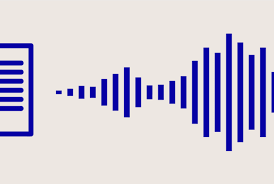Audio Text Conversion: Transforming Spoken Words into Written Content Prestige and quality

Audio text conversion, often referred to as speech-to-text or transcription, is a technology that holds immense significance in today’s information-driven world. It involves the transformation of spoken words and audio content into written text, making it more accessible and manageable. This article explores the various aspects of audio text conversion, its applications, and the impact it has on various sectors of our lives.
The Basics of Audio Text Conversion
Audio text conversion is the process of converting spoken language, which exists in the form of audio recordings, into written text. This transformation is achieved through advanced technologies that rely on speech recognition and natural language processing (NLP). The process typically involves the following steps:
- Audio Input: The source of audio content can be diverse, ranging from recorded conversations and interviews to podcasts, lectures, and more. This input can be in various formats, including audio files, streaming media, or real-time speech.
- Speech Recognition: Cutting-edge speech recognition algorithms analyze the audio input, breaking it down into individual words and sentences. These algorithms are trained on vast datasets to understand different accents, dialects, and languages.
- Transcription: Once the spoken content is converted into text, the transcription can be edited and refined for accuracy. Transcriptionists, who may be humans or automated systems, often review and correct the text to ensure it accurately reflects the spoken words.
- Text Output: The final product is a written transcript of the audio content, which can be used for various purposes.
Applications of Audio Text Conversion
The applications of audio text conversion are wide-ranging and are becoming increasingly essential in our data-driven society:
- Accessibility: One of the most significant applications is to make audio content accessible to individuals with hearing impairments. It enables them to access audio content in written form, improving their inclusion in education, entertainment, and information consumption.
- Content Creation: Audio text conversion simplifies the creation of written content. Podcasters, YouTubers, and content creators often transcribe their spoken content to reach a broader audience and improve SEO.
- Market Research: Audio content, such as customer service calls or focus group discussions, can be transcribed and analyzed for market research, customer feedback, and sentiment analysis.
- Legal and Healthcare Documentation: In the legal and healthcare sectors, audio text conversion is invaluable for transcribing court proceedings, medical dictations, and patient records. It streamlines documentation and enhances accuracy.
- Academic Research: Researchers in various fields use transcription to document interviews, surveys, and observations for qualitative analysis.
- Language Learning: Audio text conversion aids language learners by providing written transcripts of spoken content, making it easier to understand and learn from audio resources.
- Voice Assistants: Voice-activated devices and virtual assistants rely on audio text conversion to understand and respond to spoken commands and questions.
- Closed Captions: Audio text conversion is crucial for creating closed captions for videos, enhancing accessibility and comprehension for individuals who are deaf or hard of hearing.
The Impact of Audio Text Conversion
Audio text conversion has had a profound impact on several aspects of our lives:
- Accessibility: It has made audio content accessible to a broader audience, benefiting individuals with hearing impairments and those who prefer reading to listening.
- Search Engine Optimization (SEO): Transcribing audio content enhances SEO, making it more discoverable on the internet, which is essential for content creators, businesses, and organizations.
- Efficiency: In business and research, audio text conversion streamlines the documentation process, saving time and improving productivity.
- Data Analysis: Transcribed audio content can be analyzed for insights, trends, and patterns, making it valuable for decision-making and research.
- Learning and Education: It supports diverse learning styles and makes educational content more accessible and comprehensible.
Challenges and Considerations
While audio text conversion offers numerous benefits, it also presents challenges and considerations:
- Accuracy: The accuracy of automated transcription systems can vary depending on the quality of the audio, accents, background noise, and specialized terminology.
- Privacy: Audio text conversion often involves sensitive content, which raises concerns about privacy and data security, particularly in healthcare and legal contexts.
- Editing and Review: Manual review and editing of transcripts may be necessary to ensure the text’s accuracy and coherence.
- Language and Dialects: Audio text conversion systems may struggle with understanding and transcribing various languages and dialects, which can affect accuracy and comprehensibility.
- Cost: While automated transcription systems are cost-effective, quality human transcription services can be expensive, especially for large volumes of content.
Future Trends in Audio Text Conversion
The future of audio text conversion is promising, with several emerging trends:
- Enhanced AI: Continued advancements in artificial intelligence will lead to more accurate and reliable automated transcription systems.
- Multimodal Content: Integration with video, images, and other content formats will provide a more comprehensive understanding of multimedia content.
- Real-Time Transcription: Real-time transcription capabilities will become more accessible, allowing for live captioning and immediate translation.
- Privacy and Security: Future developments will prioritize the security and privacy of transcribed content, particularly in healthcare and legal contexts.
- Customization: Transcription systems will become more customizable, allowing users to define specialized terminology and preferences.
Access the link https://texttosound.com/about-
Conclusion
Audio text conversion has transformed the way we access, create, and understand audio content. It plays a critical role in enhancing accessibility, efficiency, and data analysis in various sectors. As technology continues to evolve and artificial intelligence becomes more advanced, audio text conversion will continue to shape the way we interact with spoken language and audio content, providing greater access and insight into the auditory world.
